2022 Harley-Davidson Low Rider ST Review

Defining the sport-touring cruiser
Perhaps what I love the most about the English language is its flexibility, how you can bump disparate words together and create something with an entirely new meaning. When it comes to motorcycles, the words sport and touring bring to mind two very different kinds of motorcycles. Sporting motorcycles place an emphasis on handling, acceleration, and braking, while touring bikes tend to focus on cargo capacity, rider comfort, and long-range capability. Butt those words together, as in sport-touring motorcycle, and you get a spectrum of bikes that ranges from sportbikes with bags to tourers that can corner better than you think they should. The reality of sport-touring motorcycles is that most favor the middle ground, compromising both sporting capability and touring chops, to create a supremely flexible motorcycle. What happens when you throw a third word into the mix? What would you expect from a sport-touring cruiser? Well, the folks in Milwaukee, Wisconsin have done their level best to define this category of motorcycle with the 2022 Harley-Davidson Low Rider ST.
Let’s break it down, shall we?
2022 Harley-Davidson Low Rider ST
Editor Score: 81.5%
| Engine | 18/20 | Suspension | 12/15 | Transmission | 8/10 |
| Brakes | 8/10 | Instruments | 4/5 | Ergonomics | 7/10 |
| Appearance | 9/10 | Desirability | 7.5/10 | Value | 8/10 |
+ Highs
- Milwaukee-Eight 117 cubic inch engine’s mountains of torque
- Increased cornering clearance, thanks to mid-controls and longer shock stroke
- Good weather protection with enough airflow to keep the cockpit from getting hot
– Sighs
- Awkward leg position, thanks to the mid-controls and low seat
- Reduced storage because of skinny saddlebags
- Some styling miscues
Sport
The biggest sporting component of the Low Rider ST is the Milwaukee-Eight 117 V-Twin engine. Formerly only available in Harley’s CVO models, the 117 makes an appearance in all of the ST models for 2022. For those who aren’t in the know, 117 cubic inches is a massive 1,920 cc, and what you get from this air/oil-cooled beast is a mountain of torque providing the forward thrust. Harley claims 125 lb-ft of torque at just 3,500 rpm, which is enough to motivate the claimed 721-lb motorcycle with enough alacrity to put a smile on even the most jaded rider’s face.
And the engine looks the part, with the Heavy Breather intake jutting out of the right side of the V. Internally, the 4.075 in. X 4.5 in. (103.5 mm x 114.3 mm) bore and stroke cylinders are fed by a “high-performance camshaft,” meaning we don’t actually know what the lift and duration are. The exhaust exits via a pair of two-into-two offset shotgun mufflers that have enough bark to keep most riders happy.
Unfortunately, these mufflers deliver one of the few styling miscues on the ST. The mufflers and the bracketry that supports them are chromed but hidden under a pair of black covers, drawing attention to the mounts and the mufflers’ cheap looking end caps. Otherwise, the engine bay is as pretty as we’ve come to expect from the Milwaukee-Eight.
The engine isn’t the only sporting element to the Low Rider ST. The rear suspension stroke has been increased from 43 mm to 56 mm, giving the back end a claimed 4.4 in. of travel – which is a move in the right direction. When coupled with the front end’s 5.1 in. of travel, you have the makings of a more comfortable ride than you typically get from Harley’s truncated shocks.
For spirited riding, neither the feet-forward or floorboard-restricted riding positions do the cornering clearance any favors. So, the engineers gave the ST mid-controls, resulting in a claimed 1.3° increase in lean angle. Out on the road, the improvement feels like more. In my back-country rides, only the soft rubber of the pegs touched down (thanks to the technicians at the Fleet Center removing the feelers), and my ride didn’t end with long scrapes on the lower muffler. You really can corner remarkably quickly, as long as you don’t forget how heavy the bike is.
However, before I move on to discussing how the suspension works, I’d like to take a moment to consider the mid-control riding position. In a word, blech. While the photos of my legs in the riding position show my thighs being parallel to the ground, from the saddle, my knees feel much higher. Like with the feet-forward position, the rider needs to use arm strength to get their butt out of the seat for big bumps. Harley’s obsession with low seat heights is completely to blame for this funky riding position, and if you need any proof that the feet high in front is contrary to sport riding, mounting a seat that is several inches taller is a modification race teams are making to their King of the Baggers bikes. While I’m not suggesting that a street bike go to that extreme, I do think the Low Rider ST’s riding position would benefit from at least another inch between the rider’s butt and the pavement. The good news is that the Harley aftermarket is huge and healthy. Perhaps a seat company will step in with an increased height seat for folks who feel the same way I do.
Anyone who rides the ST on the broken pavement found in most major cities will thank Harley-Davidson for the increased rear suspension travel. Bumps that would have me flinching in anticipation on other Harleys pass under the Low Rider ST much less painfully. Out on the open road, the damping soaks up the rhythmic bumps often encountered on interstate highways. On winding rural highways, the fork rewards a smooth hand, preferring to have braking pressure ramp up progressively to avoid excessive chassis pitch. Similarly, the ST likes to be bent into corners rather than being flicked. Still, the chassis stays happy to about an 8/10th pace before the weight of the bike overwhelms the suspension and frame. I experienced the hinge-in-the-middle effect of chassis flex in a couple of sweeping corners after encountering bumps. Rolling bumps in succession could tax the shock, causing it to rebound more than it should, but the bike regained composure very quickly.
Touring
Baggers have always had light-touring chops, but the Low Rider ST clearly draws on the influences of the King of the Bagger class and the burgeoning performance bagger scene. The ST’s saddlebags are raised high on the rear of the bike for better ground clearance (on the left) and are narrowed for a sleeker, sportier appearance. Consequently, they are more limited in the size and volume of items they can carry. Still, they are waterproof, locking saddlebags that operate with Harley’s easy-to-use latch, keeping them closed. Riders who want the look to be even more svelte can remove the saddlebags with the twist of a pair of quick releases, giving the bike a clean Low Rider look with just the two chromed mounting posts showing.
Much has been said of the fairing’s homage to the FXRT. What really needs to be discussed is how hard the designers worked to maintain that heritage while making the fairing functional by modern standards. The fairing retains the round headlight with the gill-like vents on either side, but now, with the help of computer-aided design and thorough testing, the ST’s fairing not only looks the part, but also performs impressively. At speed, enough air is directed at the rider via the two side vents and one over the headlight that the cockpit contains an envelope of calm but not stagnant air that both protects the rider and keeps them cool. The standard windshield was perfect for my 5-foot 11-inch frame up to speeds that wouldn’t be prudent to print. Additionally, I had no issues with cross-winds affecting handling.
One way in which the Low Rider ST’s fairing has strayed away from what you would expect to find in a touring-oriented motorcycle is the instrumentation. The fairing interior is completely free of any instrumentation. For those who want tunes when they ride, a Rockford Fosgate drop-in accessory system ($1,000) is easily installable. There are even connectors for it in the wiring harness. What you won’t get with the 125 watts per channel is anything cluttering up the inside of the fairing. The system is almost invisible and is completely controlled by an app on your smartphone.
Long-distance comfort is a primary focus in touring bikes, and the fairing’s weather protection is essential. The second-most important feature is the seat, and here, the ST scores high marks. Soft and comfortable for the long haul, the solo seat is sculpted to prevent the rider from sliding back when the throttle gets whacked open.
A touring bike’s riding position is typically quite neutral to help the rider stay relaxed over hours in the saddle. The Low Rider ST’s handlebar finds the right balance between long-distance comfort and allowing the rider to manipulate the controls in an effective manner during backroad shenanigans. The lower body’s position is equally important for comfort, and here the ST misses the mark. Having the rider’s feet high and on mid-controls folds both the knees and back quite severely. While this position can be effective for sporty rides that benefit from the increased ground clearance, touring will require frequent breaks to unkink the joints. I would be surprised if Low Rider ST owners would be comfortable enough to set the cruise control and sit back to enjoy the scenery along the highway while the tank drains to empty. Who knows, I could be wrong, and my opinion could just be the result of my 32-in. inseam. Maybe riders with shorter legs won’t feel as folded up. However, when I asked Ryan Adams, who has a 30-in. inseam, he said he felt the same way I did (but a little less stridently) after his photo model session.
Cruiser
While the sport and touring elements got a lot of attention on the Low Rider ST, it doesn’t stray too far from the cruiser roots of the platform. Cruisers cut down to the core of what makes a motorcycle a motorcycle. There is nothing that is not necessary, and this is apparent in little things like the Low Rider ST’s instrumentation. Instead of having big gauges or a TFT on the inside of the fairing, everything is neatly tucked away inside the top handlebar clamp in a LCD screen. Because the space is so small, you can toggle your way through the available information via a switch on the left handlebar.
Take the saddlebags off the ST, and you’ve got a cruiser with a frame-mounted fairing. Although the increased ride height in the rear does change the motorcycle’s stance from the classic clean, low slung line that slopes rearward to one with more of a level chassis, the elemental nature of cruisers is very much at play here.
Synergy?
Harley has taken the classic cruiser/bagger equation and massaged it into something new. Beefy Big Twin engines have always been fun in a straight line. The torque is intoxicating. Baggers have taken that performance formula to the open road (and now the race track), but both have had their cornering shortcomings, the feet-forward cruisers moreso. The use of mid-controls on the Low Rider ST is a step in the right direction, but I can’t help but think that an additional inch of seat height would make all the difference in the bike for someone with long legs like me. I recognize that saying the set-to-peg relationship needs to be changed would be monkeying around with the cruiser equation that has served Harley well for decades.
My issues with the Low Rider ST’s riding position haven’t prevented me from having a blast on the bike every time I’ve ridden it. The afternoon I picked it up, I immediately hopped on the freeway for 70 minutes of lane-splitting my way through the belly of Los Angeles’ peak traffic. The bike is extremely well balanced at slow speeds, allowing me to thread some very tight gaps. This is really quite impressive and made what could have been drudgery enjoyable. My twisty road testing loop had me laughing at times as the Milwaukee-Eight engine grunted its way out of corners before the strong brakes hauled the bike down from speed to do it all over again.
When it comes to the rest of the bike, except for the muffler niggles listed above, the Low Rider ST’s fit and finish is typical Harley fare, as in top notch. Yes, the $450 surcharge for the gray paint seems excessive, but the rest of the bike feels in line with the $22,199 ($21,749 base) price tag. Harley-Davidson produces premium motorcycles, and this one, with its clean design, impressive performance, and superior build quality, fits that category of motorcycle.
So, if you’re interested in seeing what a sport-touring cruiser is or if the 2022 Harley-Davidson Low Rider ST speaks to you, go find one for a test ride. Or at least sit on one to see if the riding position works for you. Don’t let my whinging deter you.
In Gear
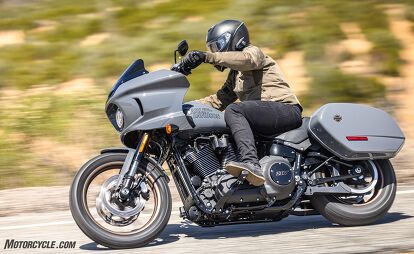
Helmet: AGV Sportmodular Tricolore
Communicator: Sena 30K (Discontinued)
Jacket: Rev’It Traction Jacket
Gloves: Rev’It Sand 4
Jeans: Pando Moto KarlDo Pants
Boots: Reax Fulton Air Riding Shoes
2022 Harley-Davidson Low Rider ST | |
|---|---|
| MSRP | $21.749 (Black), $22,199 (Gray) |
| Engine Type | 117 cu. in. Milwaukee-Eight, air/oil-cooled 45° V-Twin, 4 valves per cylinder |
| Bore and Stroke | 103.5 mm x 114.3 mm |
| Compression Ratio | 10.2:1 |
| Rear Wheel Horsepower | NA |
| Torque (Claimed) | 125 lb-ft @ 3,500 rpm |
| Transmission | 6-speed |
| Final Drive | Belt |
| Front Suspension | Single cartridge 43 mm inverted with aluminum fork triple clamps; single rate spring |
| Rear Suspension | Hidden, free piston, coil-over monoshock; 56 mm stroke; hydraulic preload adjustment |
| Front Brake | Dual four-piston calipers, dual 300 mm discs |
| Rear Brake | 4-piston fixed, 300 mm disc |
| Front Tire | Michelin Scorcher “31”, 110/90B19,62H,BW |
| Rear Tire | Michelin Scorcher “31”, 180/70B16,77H,BW |
| Rake/Trail | 28°/5.7 in |
| Wheelbase | 63.6 in. |
| Seat Height | 28.3 in. |
| Curb Weight (Claimed) | 721 lbs. |
| Fuel Capacity | 5 gal. |
| Colors | Black/Gray |
| Warranty | 24 months (unlimited mileage) |
We are committed to finding, researching, and recommending the best products. We earn commissions from purchases you make using the retail links in our product reviews. Learn more about how this works.
Become a Motorcycle.com insider. Get the latest motorcycle news first by subscribing to our newsletter here.

Like most of the best happenings in his life, Evans stumbled into his motojournalism career. While on his way to a planned life in academia, he applied for a job at a motorcycle magazine, thinking he’d get the opportunity to write some freelance articles. Instead, he was offered a full-time job in which he discovered he could actually get paid to ride other people’s motorcycles – and he’s never looked back. Over the 25 years he’s been in the motorcycle industry, Evans has written two books, 101 Sportbike Performance Projects and How to Modify Your Metric Cruiser, and has ridden just about every production motorcycle manufactured. Evans has a deep love of motorcycles and believes they are a force for good in the world.
More by Evans Brasfield



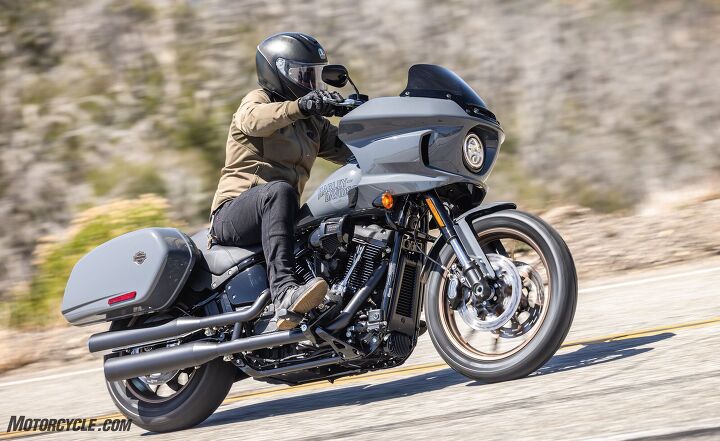





















































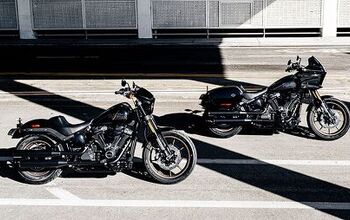
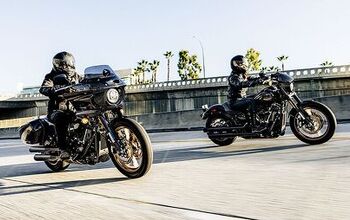
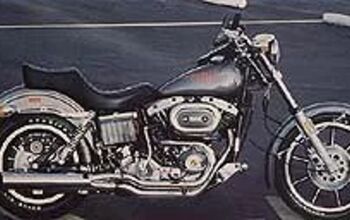

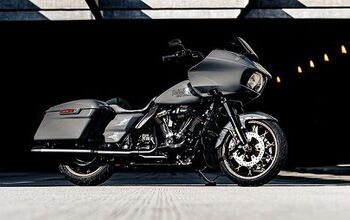












Comments
Join the conversation
This bike, with a thicker seat that places me a bit higher on it and cushions my tush, would be the one in Harley's lineup if the modified riding position works for me. The longer travel inverted forks and shocks are sweet indeed. Have managed to never have owned a Harley but have ridden a few. I understand the appeal and the uprated engine in this bike takes that primal big twin appeal and puts some good meaty accessible roll on power juice behind it with the 117 engine.
Have always been put off by how low to the ground Harleys are and their short travel suspension. American roads suck and short travel beats up the rider. Currently on a Super T with a Daylong seat and hard boxes on it that I can do 500 mile days on no problem. With 7.5 inches of travel front and rear, the bike (with Penske shock and revalved/resprung forks) floats over stuff that would rattle kidneys on my sport bike, and it rides better than my pickup does on the slab.
While it technically is an adventure bike, in my twisted dirt biker for the last 48 years warped brain, my Super T with it's road hugging weight, carrying capacity, roomy ergonomics and laid back engine demeanor that prefers to stretch it's legs and cruise from here to way the Hell over there than to rip around on short hops is a bagger - it is just a tall bagger. Life is short though, at some point I suppose I need to own a real bagger.
I just realized something... Everybody's complaining about the seat height... On a bike that's literally called the Low Rider 🤭😂🤣